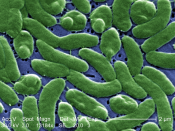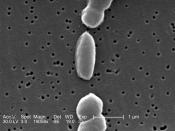Vibrio vulnificus infection is the leading cause of death related to seafood consumption in the United States. The CDC estimates that 8028 Vibrio infections and 57 deaths occur annually in the United States. I will be informing you on Vibrio vulnificus and Vibrio parahaemolyticus. In this research, I will discuss the definition and how it is transmitted, type's symptoms, diagnosis and treatment, and prevention of vibrios vulnificus. First described in 1976, Vibrio vulnificus is a halophilic bacterial species that causes primary septicemia and wound infections. Between 1989 and 2008, 520 ingestion cases with 263 deaths 51% were reported. Most of the cases occurred in men over the age of 40, as estrogen appears to block the endotoxin produced by this species. This pathogen is an opportunistic, with infections largely restricted to those having underlying liver diseases. This bacterium may infect an individual if ingested or can enter the body through an open wound.
From there, it invades the GI tract or blood and can lead to septicemia, depending if the person is healthy or has a vulnerable immune system. Other members of this family include Vibrio cholerae which is rare in the United States and Vibrio parahaemolyticus, both of them cause severe gastrointestinal illness followed by severe diarrhea. Transmission of Vibrio infections are two ways, first, is caused by consuming raw or undercooked seafood, particularly raw oysters. The second is a necrotizing wound infection acquired when an open wound is exposed to warm seawater with high concentrations of vibrio vulnificus.
This disease in humans' comes from contamination of a skin lesion or ingestion of contaminated seafood. Vibrio vulnificus typically cause disease in people who eat contaminated seafood. The infectious dose of vibrio vulnificus is believed to be low and fatal infections have been reported after the ingestion of a single...


